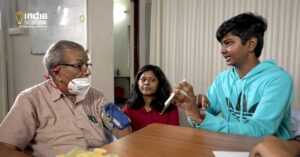IIT Roorkee Investigates Tamarind Seeds, Discovers Potential Cure for Chikungunya
While the virus has been dubbed as one with ‘no cure’, treatment or even a vaccine for the longest time, researchers at IIT Roorkee may spell new hope for patients.

My colleague at The Better India, Vidya Raja, was recently diagnosed with Chikungunya.
She shares, “I never understood it when people said that the joint pain was incomparable. But now I do. Imagine little people inside your body, seated on your bones hammering on the joints – that’s the way I can best describe the pain. Because it is something that only you experience.”
Characterised by bouts of fever, nausea, headaches, rashes and unbearable joint pain, Chikungunya can be an extremely taxing to those it affects.
In 2010, Delhi witnessed an outbreak of Chikungunya with five cases. Although it saw a decline, cases were being reported sporadically.

By 2016, however, 60,000 cases were reported, in one of the worst outbreaks. Although there were no deaths, New Delhi and the National Capital Region were the worst hit in the last 10 years, with thousands of households being bedridden.
And while the virus has been dubbed as one with ‘no cure’, treatment or even a vaccine for the longest time, researchers at IIT Roorkee may spell new hope for patients.
In a study published in the journal Virology, the team led by Shailly Tomar from the Department of Biotechnology has found a protein in tamarind seeds that reduces the infectivity of the chikungunya virus.
According to a report in The Hindu, the researchers who received promising results obtained through in-vitro studies, (in a laboratory, without using any live animals) are now planning to test the protein on animals to prevent and/or treat chikungunya infection.
The study has confirmed that the sugar moiety on the surface of alphaviruses has a role in infectivity. The team found the tamarind protein (tamarind chitinase-like lectin or TCLL) binds to the sugar moiety (N-acetylglucosamine or NAG) present on the surface of the chikungunya virus.
When the protein binds to the sugar molecule, it coats it in a way that the chikungunya virus is not able to attach to or attack the cell. Thus leaving the cell at a relatively lower risk of contracting the infection.
Pravindra Kumar, who is the co-author on the published paper, revealed that their structural studies clarified that the TCLL protein specifically binds to NAG sugar molecules.
“Since tamarind seeds are traditionally used in Ayurveda to treat many ailments and conditions, we wanted to know the molecules in the seed. Two proteins were found in abundance. Based on amino acid sequence, we found one protein has both anticoagulant and blood thinning properties while TCLL, which is a lectin protein, binds specifically to NAG sugar molecules,” he told The Hindu.
The team’s hypothesis was–If the TCLL protein binds to NAG, the virus will not be able to attach and interact with host cell receptors reducing infection.
“We found that the NAG molecule binds to the TCLL protein and prevents the protein from binding to the virus. This helped confirm that TCLL binds to chikungunya virus through NAG,” Prof Tomar told the publication.
The team incubated TCLL protein of different doses with the virus for different intervals. The results were astonishing. It showed that 100 micromolar of the protein incubated with the virus for just 30 minutes were sufficient to cause a 64% drop in infectivity.
When asked why only 64% reduction in infectivity was seen, Ramanjit Kaur from IIT Roorkee, who is also the first author of the paper, said, “Besides NAG, there could be other sugar molecules through which the virus interacts with the host cells. Also, there may be other receptors on the host cells which allow the virus to get into the cells.”
The results were also analysed by measuring the RNA levels inside the infected cells, which showed that the treatment of the virus with TCLL led to a reduction of 45% chikungunya RNA levels inside the host cells.
Read More: IIT-Mandi Innovates Eco-Friendly Fuel That Prevents Forest Fires, Boosts Local Livelihoods!
“The TCLL protein can bind to glycan found on nearly 30 members of the alphavirus genus. So the finding of this study has huge implications,” Prof Tomar signed off.
The professor-duo has now filed a patent for chikungunya antiviral composition consisting of TCLL protein.
Hearing of these developments, Vidya shares, “From what I know, there are no medicines, to help treat or reduce the pain. I was given paracetamol and painkillers, which honestly, did nothing for me. So any breakthrough to treat the pain would be more than welcome.”
Who would have thought the quintessential ‘imli’ seeds (that otherwise get thrown out) would be a potential cure for a viral infection conventionally considered incurable!
We wish the team the very best!
(Edited by Shruti Singhal)
Like this story? Or have something to share?
Write to us: [email protected]
Connect with us on Facebook and Twitter.
This story made me
- 97
- 121
- 89
- 167
Tell Us More
We bring stories straight from the heart of India, to inspire millions and create a wave of impact. Our positive movement is growing bigger everyday, and we would love for you to join it.
Please contribute whatever you can, every little penny helps our team in bringing you more stories that support dreams and spread hope.



















